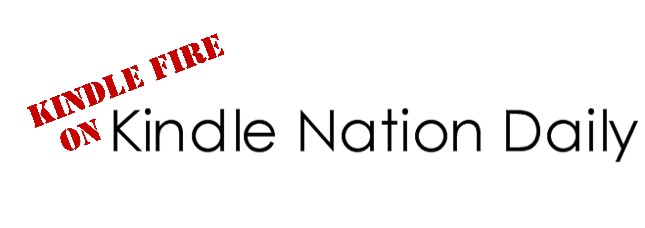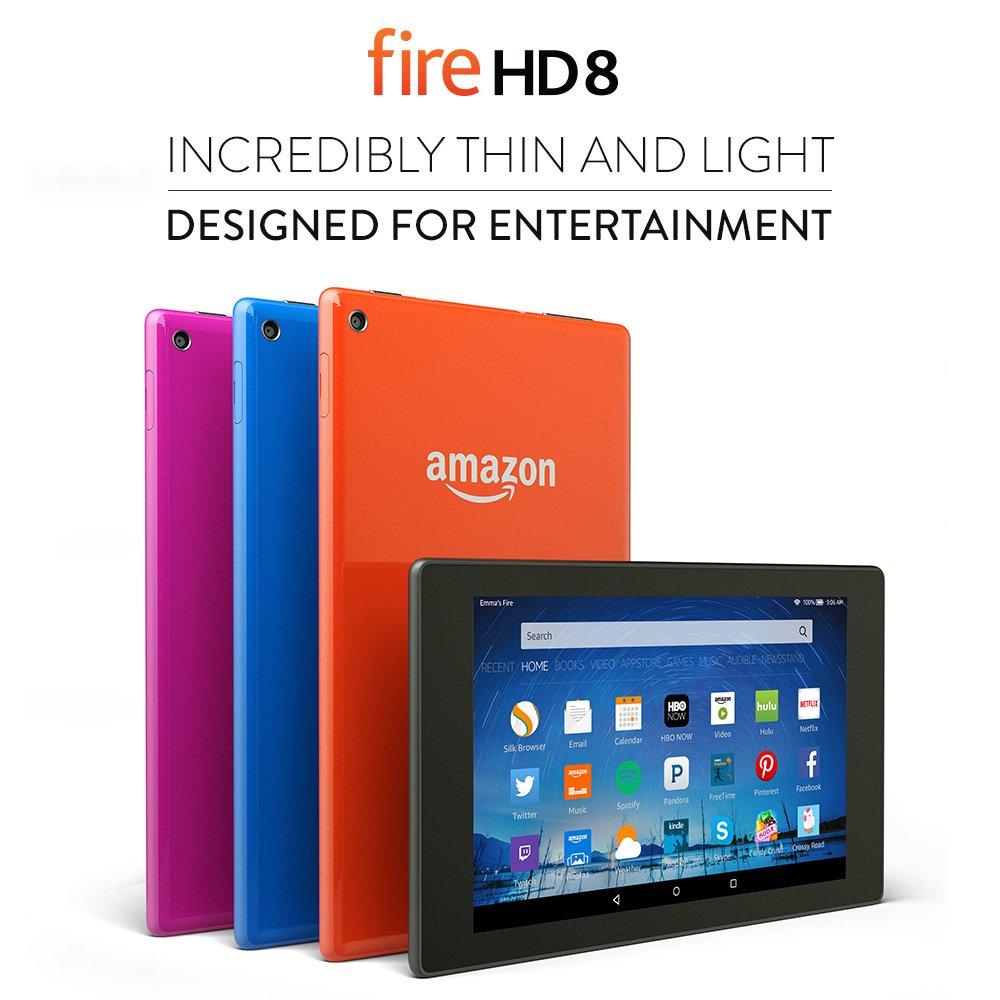It’s your friendly KF on KND Editor April Hamilton here, ready to give you the scoop on the new, 5th generation line of Fire tablets. So much has changed since the 4th generation, one post isn’t enough space to share everything. So today I’m kicking off a series of articles, one to run each day this week, describing all the changes in the new Fire tablet line. My observations are based on testing a Fire HD 8 (the one pictured above left), but the new operating system is the same across all the new models and where there are hardware differences, I’ll point them out.
Hardware Updates & Upgrades
I could spit out all the specs for the new Fires here, but they probably wouldn’t mean much unless you have a basis of comparison. So here’s Amazon’s own table listing the specs for all currently-available Fire tablet models, including the 4th generation HD6 (second column from left). When looking at details for the new models (all labeled “new” in the table), comparison to the HD6 will give you a good idea of what’s been upgraded. In particular, notice how close the specs are between the new Fire HD and last year’s HD6.
Tap or click on images to view an enlarged version in a new tab or window.
As you can see in the table, the most significant hardware changes are in the cameras (now higher resolution), Dolby audio system, and the addition of microSD card slots in all the new models. Also, the Fire HD 8 is available in four color choices and the HD 10 is available in black or white.
Click here to view the product page for the Fire HDX 8.9″, where there’s a similar table comparing previous model-year Fires. Note that the page is available as of this writing (9/28/15) but will disappear when Amazon stops selling refurbished versions of this model.
Hardware: My Observations
The first thing I noticed in terms of the hardware is the far superior sound quality. The HD6 only has one speaker and mono sound (as opposed to stereo), and it always frustrated me that the upper volume limit seemed much too low when playing anything through that speaker. The HD6 seemed to come with an assumption the user would always use headphones when watching videos or listening to audio content, but a lot of the time I wanted to use the speaker. The HD 8’s speakers blow the HD6’s sound quality and volume level right out of the water, and the sound is nothing short of amazing when you plug in a quality set of stereo headphones.
The display is noticeably crisper, too. This will seem counter-intuitive, because if you compare the Pixels Per Inch (ppi) stats on the new models to those for last year’s models, the current model ppi values are significantly lower. This is because the relationship between resolution (e.g., HD vs. SD) isn’t simply a matter of higher ppi = higher resolution. If you want to get into the nitty gritty on it, see this article on Know Your Mobile. Otherwise, you can just take my word for it: the HD 8’s display is fantastic.
The other big news here is the MicroSD card slot, which enables you to download much more content than in the past, store more videos and photos of your own, or (where supported by the app) install apps directly to the card / store app save files to the card. Note that when you insert a card, the Fire will notify you that all photo, video and supported app content will be saved to the card by default, but that you can change this in the Settings area.
Bellini Operating System
As in the past, the new Fire line’s operating system is an Amazon-customized version of Android. Bellini is based on Android Lollipop, and it’s a LOT different than any Fire operating system that’s come before. It’s going to take some getting used to, and you should expect a learning curve.
I’ll be digging into Bellini more deeply later this week, in posts that address each different content type menu. For now, let’s just look at the big picture.
Bellini is a lot more like a smartphone operating system than previous Fire operating systems. The unlock screen that displays when you first turn the tablet on is like the one on a smartphone: there’s a very small menu ribbon at the bottom of the lock screen with a padlock icon you have to swipe upward on to unlock the screen. Once unlocked, there’s also the same kind of 3-icon main menu at the bottom of the screen that you’d typically find on a smartphone (the bottom icon menu is shown on the Fires in the image above: triangle=back, circle=home, square=recent).
The main menu screens look very much like those on a smartphone: you see a grid of icons on the Home screen, and you swipe left or right to move between content menu screens (see the first screen shot at the top of this post, which shows the Home screen: the image shown immediately above is of a content menu screen, and content screens don’t have the icon grid). Small dots in the margin of the main menu screens indicate when additional screens are available, and you swipe up or down to move between them.
Again, I’ll go into much more detail later in the series but for now, I’ll just say that when you’re in doubt as to how to do something on a new Fire, just ask yourself how you’d do that thing on an Android smartphone.
Bellini is not exactly like a smartphone operating system. Amazon has incorporated the content menu ribbon Fire owners are used to (Recent, Home, Books, Games, Apps, Videos, etc.), and the end result is kind of a smartphone/Fire hybrid. This means that while a lot of what you’d do on an Android smartphone works the same way on the new Fires, not everything does. For example, on a smartphone you’d have to tap an icon to launch Kindle Reader, Amazon Video, Amazon Music or Audible, but these are built right into the operating system on the new Fires and are accessed the same way as in previous generations of Fire tablets: via the content menu ribbon at the top.
The new screen memory feature: you’ll love it or hate it.
**UPDATE 9/28/15** A couple of software updates have been released in the past couple of days and have altered this feature. Now, each content menu screen “remembers” the most recent items you’ve accessed, but no longer takes you back to the last screen, menu or Amazon product page you drilled down to most recently. More details to be provided on this when I cover the individual content menus later this week.
Collections are no longer supported for apps and games. This one is a major disappointment to me, because I own HUNDREDS of apps and have spent a lot of time grouping them into collections. In Bellini, you can sort alphabetically or by recent, and that’s it. Collections are still there for books and audiobooks, however.
Your video library can now be sorted alphabetically. For people who own a LOT of digital videos, this is a HUGE improvement over previous Fires, which would only display your video library in order of date purchased. I very much hope this same sort will be available in the new Fire TV operating system.
That’s all for now. Be sure to tune in each day this week, same time and place, for more in-depth articles about each of the different Fire content menus and how they’ve changed.
* * *
Tech Tip of the Week: Be Reasonable About The Limitations Of Tech
* * *





I love my HDX 8.9. The new HD10 has some really good features such as the SD card ability and while the price of the HD10 is less than 50% of the old HDX the processor of the HD10 is about half the speed and the PPI is also less than half of the HDX’s. How does the picture of the new HD10 compare with the HDX? Both for video and text? Also, is Amazon planning to release a more expensive but better HDX line?
First, sorry for the late reply. We’ve been inundated with spam lately and that makes it harder to spot legitimate comments and questions.
It’s impossible to know what Amazon may or may not have planned, in terms of future hardware releases. They never announce long term plans for their product lines.
RE: HD10 vs existing HDX displays, don’t be misled by the PPI stat. Resolution on HD displays isn’t so simple to parse as back in the days of VGA displays. I have a 2013 HDX and a 2015 HD 8, and even though the PPI is listed as higher for the HDX the HD 8 definitely has a noticeably crisper display.
RE: processor speed, this also isn’t an apples-to-apples comparison because it’s a totally different operating system that has many new, built-in improvements in processing efficiency. The HD8 is definitely zippier than my HDX, and this is particularly noticeable when streaming video or using the browser. The browser is also SO MUCH better in the 2015 line, it just blows the previous generation right out of the water. But having said that, I admit I don’t do a lot of web surfing on my tablets.
I’ve switched to using the HD8 pretty much exclusively, but I will say this: it’s a bit buggy, compared to my HDX. I’ve noticed new software updates and patches keep coming, so I can tell Amazon’s engineers are actively working on the bugs and they’re not so irritating that I’ve switched back to the HDX.
Bottom line: the 2013 HDX is a great tablet, and if Amazon had never released a new line this year I wouldn’t feel like I was missing out on anything. However, the display and speed improvements are very nice to have in the new tablet, particularly if you use yours for a lot of web surfing or video watching. The memory card slot in the new line is another thing to consider, since the HDX lacks that. Hope this helps.